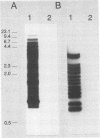Abstract
A polymerase chain reaction (PCR) assay which allows the simultaneous detection and discrimination of the two causative agents of pertussis, Bordetella pertussis and Bordetella parapertussis, was developed. Primer pairs were based on insertion sequence elements IS481 and IS1001. IS481 is specific for B. pertussis and is present in about 80 copies per cell, while IS1001 is specific for B. parapertussis and is found in 20 copies per cell. An internal control was included in the PCR assay to monitor the performance of the PCR and to identify possible inhibitory components in clinical samples. Discrimination of amplified DNA derived from the internal control, B. pertussis, or B. parapertussis was accomplished by differential spacing of the primers. The sensitivity of the combined PCR method was found to be very high and allowed the detection of one cell of either pathogen. The usefulness of the method was investigated by using a limited number of clinical samples derived from patients with serologically proven pertussis.
Full text
PDF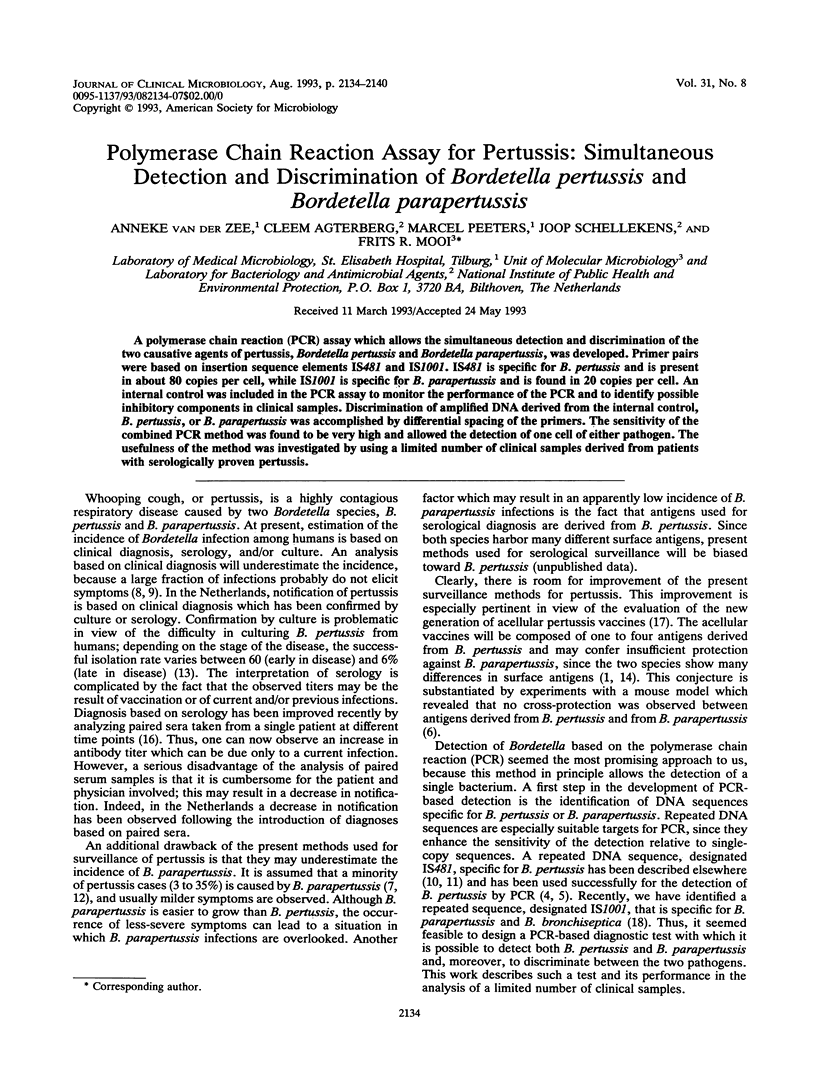
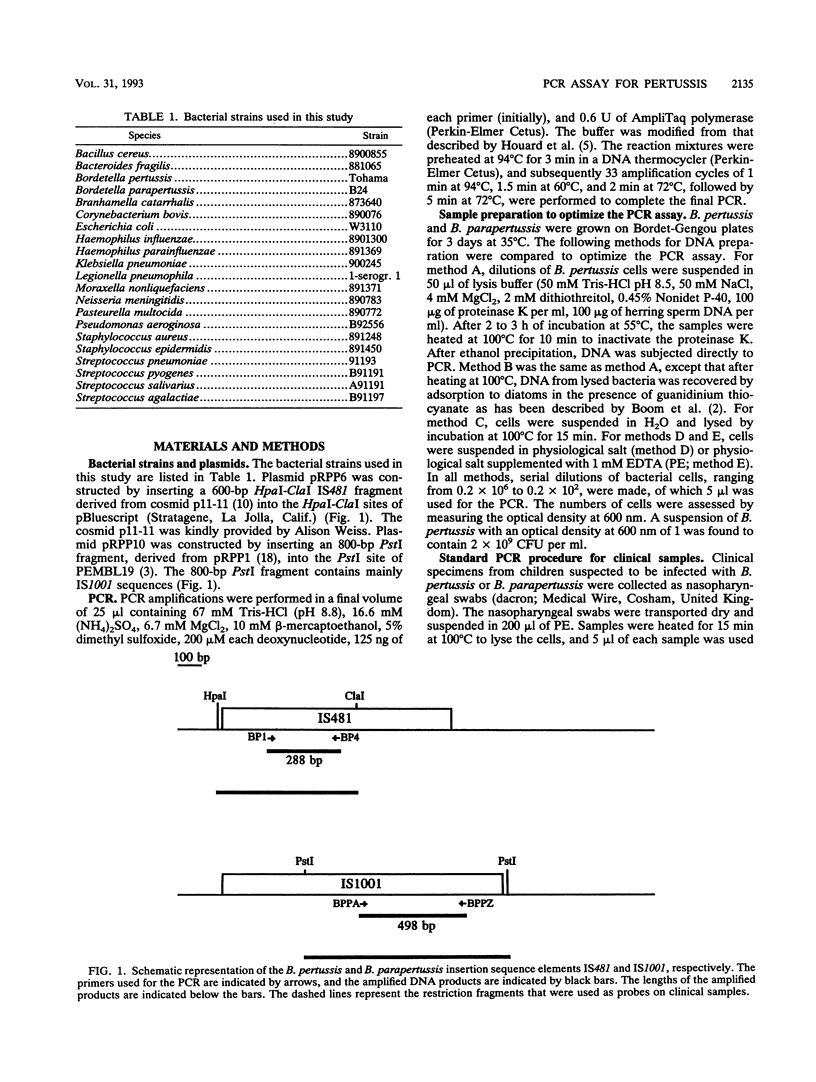
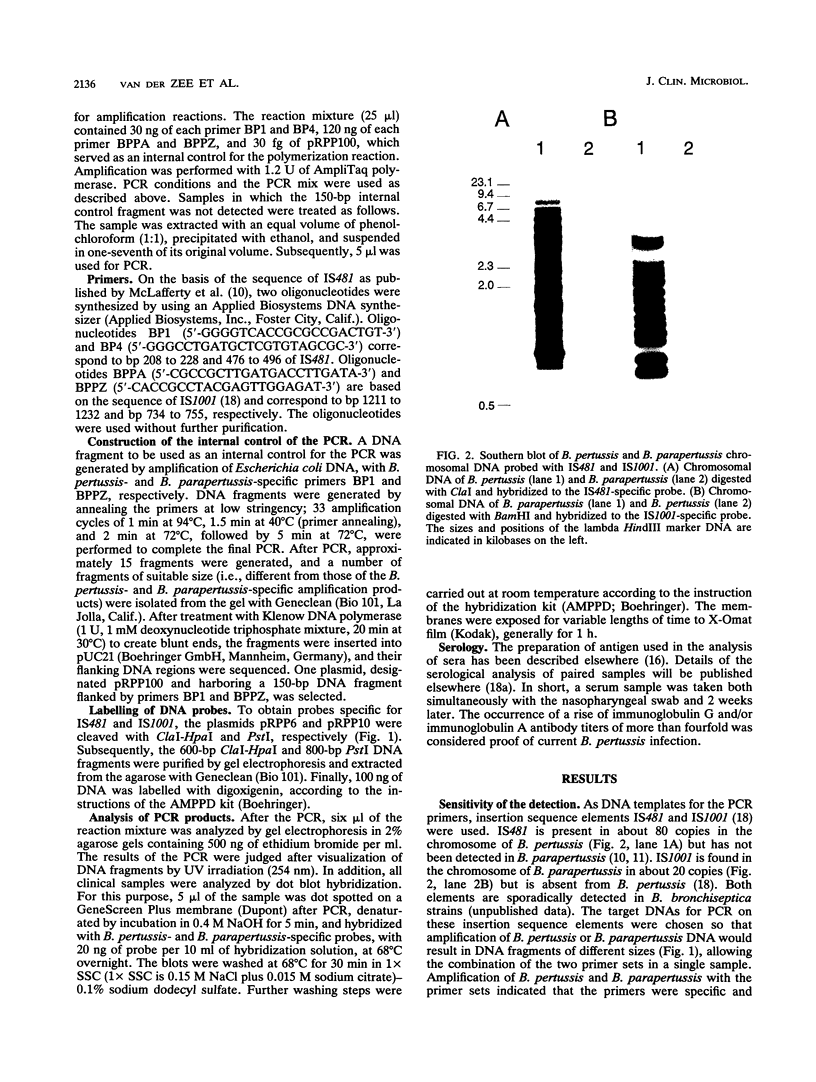
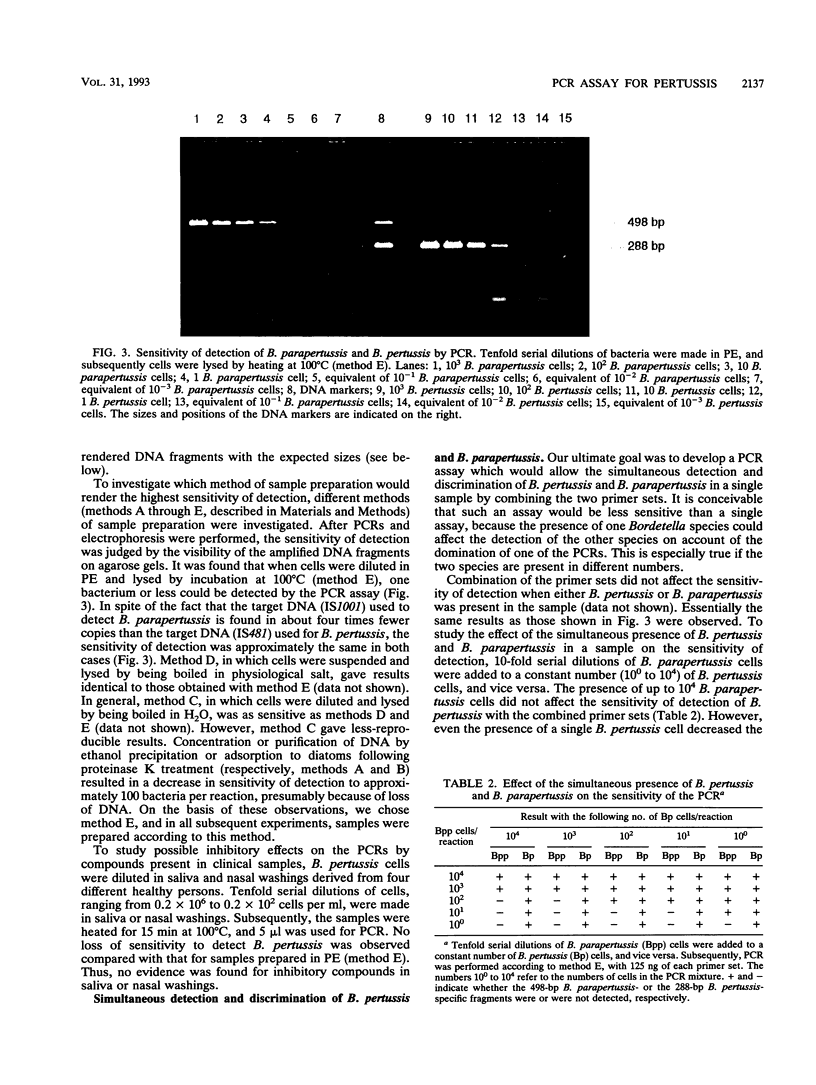

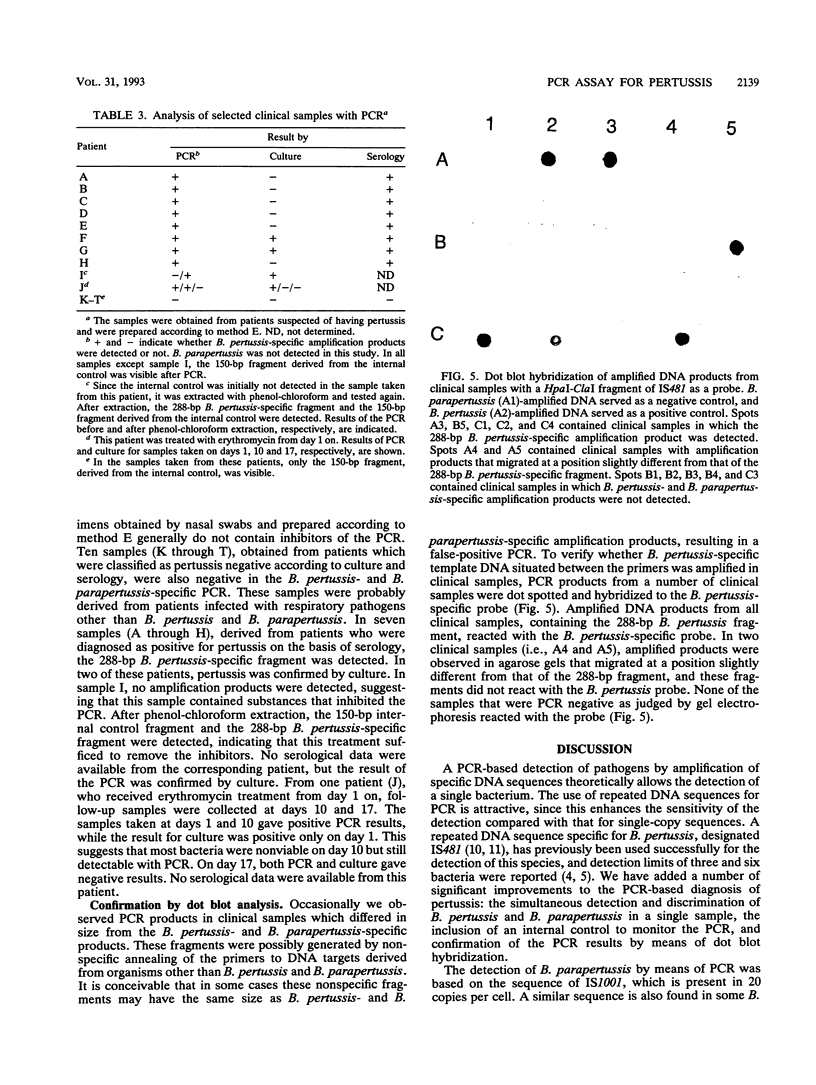
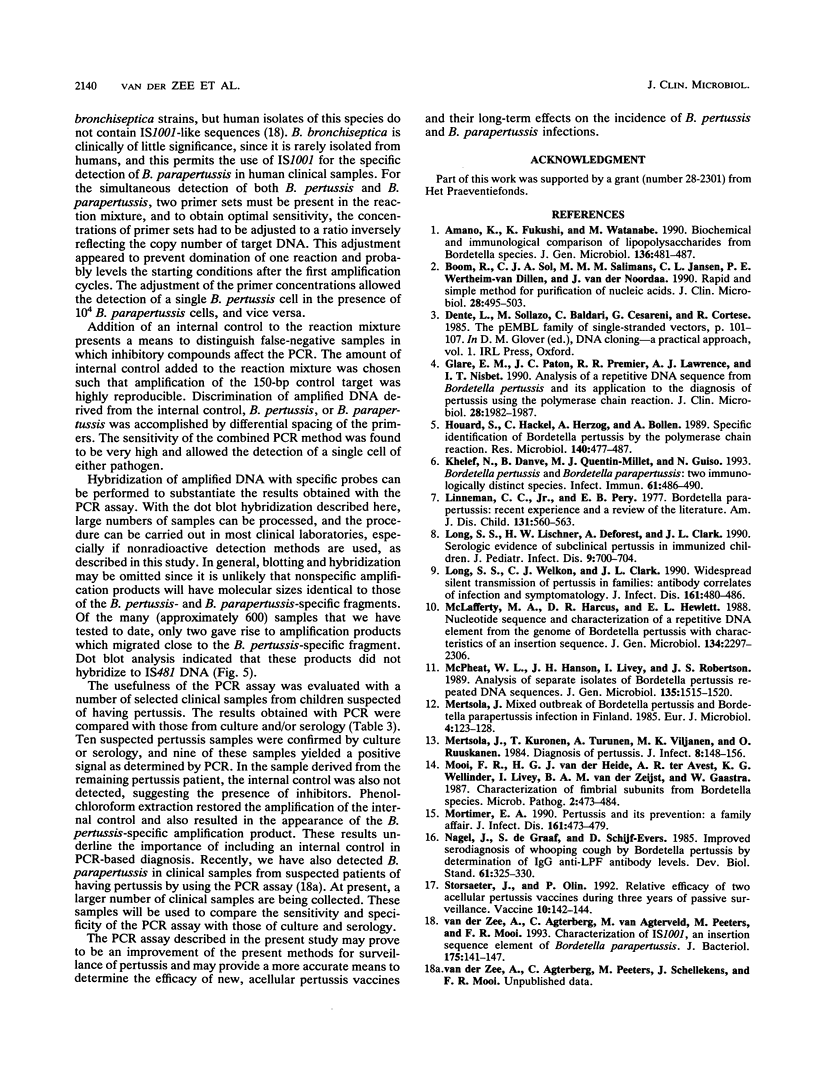
Images in this article
Selected References
These references are in PubMed. This may not be the complete list of references from this article.
- Amano K., Fukushi K., Watanabe M. Biochemical and immunological comparison of lipopolysaccharides from Bordetella species. J Gen Microbiol. 1990 Mar;136(3):481–487. doi: 10.1099/00221287-136-3-481. [DOI] [PubMed] [Google Scholar]
- Boom R., Sol C. J., Salimans M. M., Jansen C. L., Wertheim-van Dillen P. M., van der Noordaa J. Rapid and simple method for purification of nucleic acids. J Clin Microbiol. 1990 Mar;28(3):495–503. doi: 10.1128/jcm.28.3.495-503.1990. [DOI] [PMC free article] [PubMed] [Google Scholar]
- Glare E. M., Paton J. C., Premier R. R., Lawrence A. J., Nisbet I. T. Analysis of a repetitive DNA sequence from Bordetella pertussis and its application to the diagnosis of pertussis using the polymerase chain reaction. J Clin Microbiol. 1990 Sep;28(9):1982–1987. doi: 10.1128/jcm.28.9.1982-1987.1990. [DOI] [PMC free article] [PubMed] [Google Scholar]
- Houard S., Hackel C., Herzog A., Bollen A. Specific identification of Bordetella pertussis by the polymerase chain reaction. Res Microbiol. 1989 Sep;140(7):477–487. doi: 10.1016/0923-2508(89)90069-7. [DOI] [PubMed] [Google Scholar]
- Khelef N., Danve B., Quentin-Millet M. J., Guiso N. Bordetella pertussis and Bordetella parapertussis: two immunologically distinct species. Infect Immun. 1993 Feb;61(2):486–490. doi: 10.1128/iai.61.2.486-490.1993. [DOI] [PMC free article] [PubMed] [Google Scholar]
- Linnemann C. C., Perry E. B. Bordetella parapertussis. Recent experience and a review of the literature. Am J Dis Child. 1977 May;131(5):560–563. doi: 10.1001/archpedi.1977.02120180074014. [DOI] [PubMed] [Google Scholar]
- Long S. S., Lischner H. W., Deforest A., Clark J. L. Serologic evidence of subclinical pertussis in immunized children. Pediatr Infect Dis J. 1990 Oct;9(10):700–705. doi: 10.1097/00006454-199010000-00003. [DOI] [PubMed] [Google Scholar]
- Long S. S., Welkon C. J., Clark J. L. Widespread silent transmission of pertussis in families: antibody correlates of infection and symptomatology. J Infect Dis. 1990 Mar;161(3):480–486. doi: 10.1093/infdis/161.3.480. [DOI] [PubMed] [Google Scholar]
- McLafferty M. A., Harcus D. R., Hewlett E. L. Nucleotide sequence and characterization of a repetitive DNA element from the genome of Bordetella pertussis with characteristics of an insertion sequence. J Gen Microbiol. 1988 Aug;134(8):2297–2306. doi: 10.1099/00221287-134-8-2297. [DOI] [PubMed] [Google Scholar]
- McPheat W. L., Hanson J. H., Livey I., Robertson J. S. Analysis of separate isolates of Bordetella pertussis repeated DNA sequences. J Gen Microbiol. 1989 Jun;135(6):1515–1520. doi: 10.1099/00221287-135-6-1515. [DOI] [PubMed] [Google Scholar]
- Mertsola J., Kuronen T., Turunen A., Viljanen M. K., Ruuskanen O. Diagnosis of pertussis. J Infect. 1984 Mar;8(2):149–156. doi: 10.1016/s0163-4453(84)92559-3. [DOI] [PubMed] [Google Scholar]
- Mertsola J. Mixed outbreak of Bordetella pertussis and Bordetella parapertussis infection in Finland. Eur J Clin Microbiol. 1985 Apr;4(2):123–128. doi: 10.1007/BF02013576. [DOI] [PubMed] [Google Scholar]
- Mooi F. R., van der Heide H. G., ter Avest A. R., Welinder K. G., Livey I., van der Zeijst B. A., Gaastra W. Characterization of fimbrial subunits from Bordetella species. Microb Pathog. 1987 Jun;2(6):473–484. doi: 10.1016/0882-4010(87)90054-4. [DOI] [PubMed] [Google Scholar]
- Mortimer E. A., Jr Pertussis and its prevention: a family affair. J Infect Dis. 1990 Mar;161(3):473–479. doi: 10.1093/infdis/161.3.473. [DOI] [PubMed] [Google Scholar]
- Nagel J., de Graaf S., Schijf-Evers D. Improved serodiagnosis of whooping cough caused by Bordetella pertussis by determination of IgG anti-LPF antibody levels. Dev Biol Stand. 1985;61:325–330. [PubMed] [Google Scholar]
- Storsaeter J., Olin P. Relative efficacy of two acellular pertussis vaccines during three years of passive surveillance. Vaccine. 1992;10(3):142–144. doi: 10.1016/0264-410x(92)90002-2. [DOI] [PubMed] [Google Scholar]
- van der Zee A., Agterberg C., van Agterveld M., Peeters M., Mooi F. R. Characterization of IS1001, an insertion sequence element of Bordetella parapertussis. J Bacteriol. 1993 Jan;175(1):141–147. doi: 10.1128/jb.175.1.141-147.1993. [DOI] [PMC free article] [PubMed] [Google Scholar]



